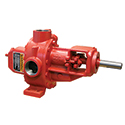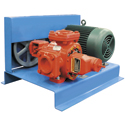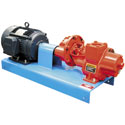How Gear Pumps Work
 by Tom Hansen, P.E. | © Dultmeier Sales
by Tom Hansen, P.E. | © Dultmeier Sales
What is a Gear Pump?
Dultmeier Sales offers a variety of Gear Pumps and Gear Pump units. Gear pumps, unlike centrifugal pumps, are a positive displacement pump and are a very good choice for transferring viscous or highly viscous liquids.
Gear pumps come in two distinct types: external gear pumps and internal gear pumps.
- External gear pumps include two external gears (inside the pump housing), one being a drive gear and the other being an idler gear.
- Internal gear pumps include one external gear and one internal gear located inside the external gear (both inside the pump housing).
Gear pumps include tight tolerances and rigid gear & housing designs which allow for pumping liquids at higher pressures than centrifugal pumps and also pumping much more viscous liquids.
Tolerance, Flowrate & Speed
Gear Pumps are not; however, a good choice for pumping liquids with solids in them due to the tight tolerances and resulting damage to the gears and other components. In addition, gear pumps generally do not pump as high of flowrates as centrifugal pumps in lower discharge pressure applications. Most gear pumps also need to be run at much lower speeds (generally 300-600 RPM) than centrifugal pumps which requires the use of gear reducers or belt drive systems. The higher the viscosity of the liquid being pumped, the lower the speed of gear pump required.
Since gear pumps are a positive displacement pump, they will provide very little variation of flowrate (a "fixed" flowrate primarily) even with increasing or decreasing discharge pressure in the system. This means that horsepower required for a given gear pump will increase as discharge pressure increases. Horsepower required for a given gear pump will also increase as viscosity increases (which increases the discharge pressure in the piping system due to increased friction losses of the more viscous liquid on the piping walls and other plumbing components in the system).
Pressure Relief
Another important requirement for gear pump systems is to include a pressure relief valve in the discharge piping (fairly close to the pump itself) to relieve pressure back to the storage tank or other liquid supply source, when downstream valves are shut off. Some gear pumps include a built-in pressure relief valve which will provide the same critical pressure relief but only for very short time periods. This is because the built-in pressure relief valves are internal to the gear pump and simply recirculate the liquid inside the gear pump itself. Recirculation inside the gear pump for other than very short time periods will cause the liquid to build heat quickly and will eventually ruin seals, packings or other key gear pump components.
Explore some of our Gear Pump manufacturers and product lines here!
 2" - 3" Roper Gear Pumps
2" - 3" Roper Gear Pumps
 Belt Driven Gear Pump Units
Belt Driven Gear Pump Units
 Gear Reduction Gear Pump Units (Electric Motor or Engine Driven)
Gear Reduction Gear Pump Units (Electric Motor or Engine Driven)
 Shertech Pumps
Shertech Pumps
 Roper Pumps
Roper Pumps
 Oberdorfer Pumps
Oberdorfer Pumps © Copyright Dultmeier Sales, LLC this material cannot be utilized in any way including on other websites or publications without the express written permission of Dultmeier Sales.












